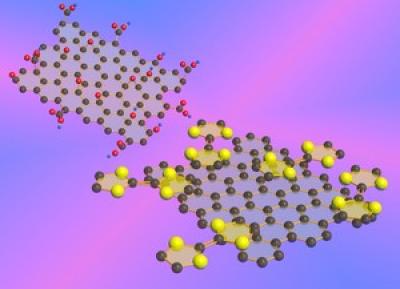Graphene is a single-layer sheet of carbon atoms. The structure of graphene consists of six-member carbon rings, resembling a honeycomb.

Sheet of Graphene Oxide with TTF molecules(Credit: IPC PAS, Piotr Gdziorowski)
The single layer, two dimensional structures imparts the properties unique to graphene such as transparency, flexibility, strength, electrical and thermal conductivity. Graphene is thus suitable for use in electronic circuits and sensors. While it holds great potential, graphene is expensive and difficult to fabricate. A collaborative research between Institute of Physical Chemistry of the Polish Academy of Sciences (IPC ACS), Warsaw and the Interdisciplinary Research Institute (IRI) in Lille, France addresses this problem by presenting a new graphene fabrication technique that is simple and can be carried out in any laboratory without the need for complex equipment.
The discovery of graphene took place in 2004 when scientists used a scotch tape to strip away layers of carbon from graphite. Existing methods for graphene fabrication require complex procedures and special and expensive equipment. The most common techniques include chemical vapor deposition, physical vapor deposition or deposition of the epitaxial layer on silicon carbide or metal substrate. The method devised by IRI and IPC PAS involves the use of common laboratory equipment, the ultrasonic cleaner. The team started off with graphite composed of multi-layered graphene sheets. The graphite was oxidized by the Hummers method to weaken the interaction between the graphene layers. The resulting graphite oxide powder was suspended in water and positioned in the ultrasonic cleaner. The exfoliation by the cleaner produced graphene oxide flakes of 300 nm in diameter. The presence of oxygen groups makes the material more of an insulator than a conductor. So to remove the oxygen groups, the team employed non-covalent pi-pi stacking bonds between graphene oxide and a compound called tertathiafulvalene (TTF). TTF comprises two aromatic rings of two sulphur atoms and three carbon atoms each. When this compounded mixture is placed in the ultrasonic cleaner, the TTF gets oxidized and the graphene oxide is reduced to graphene. Graphene flakes ranging from 100 to 500 nm thickness were obtained by depositing a drop of the composite solution on an electrode and drying it. The TTF molecules were ejected from the graphene coating by means of a chemical reaction.
Disclaimer: The views expressed here are those of the author expressed in their private capacity and do not necessarily represent the views of AZoM.com Limited T/A AZoNetwork the owner and operator of this website. This disclaimer forms part of the Terms and conditions of use of this website.